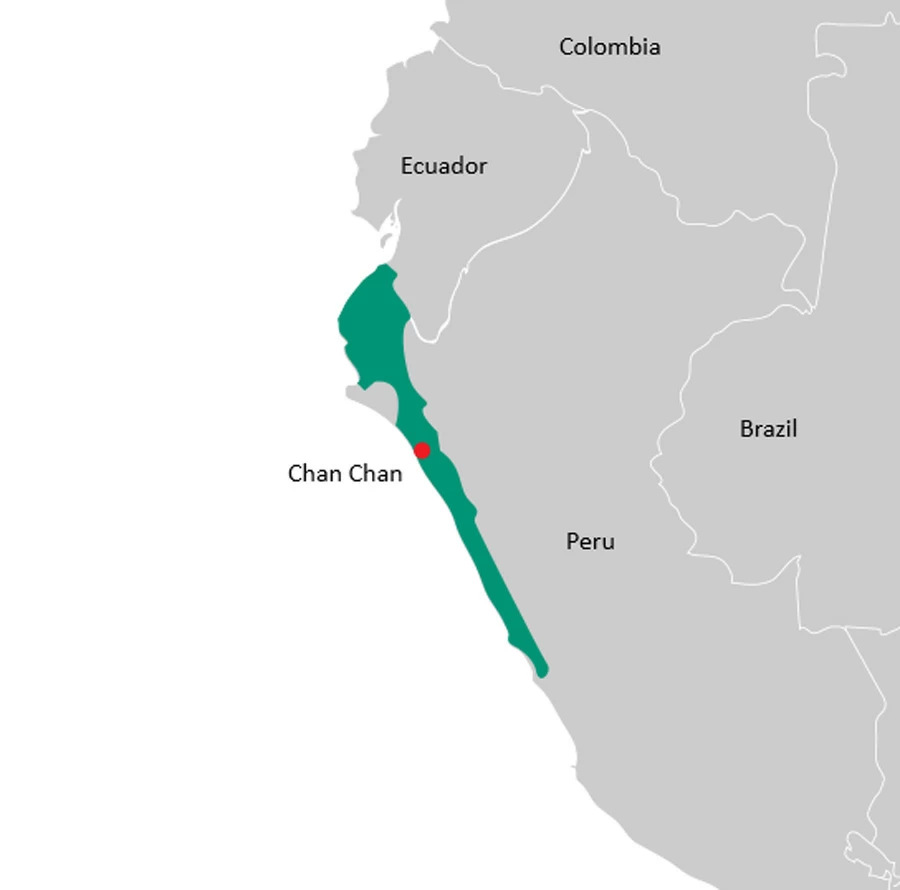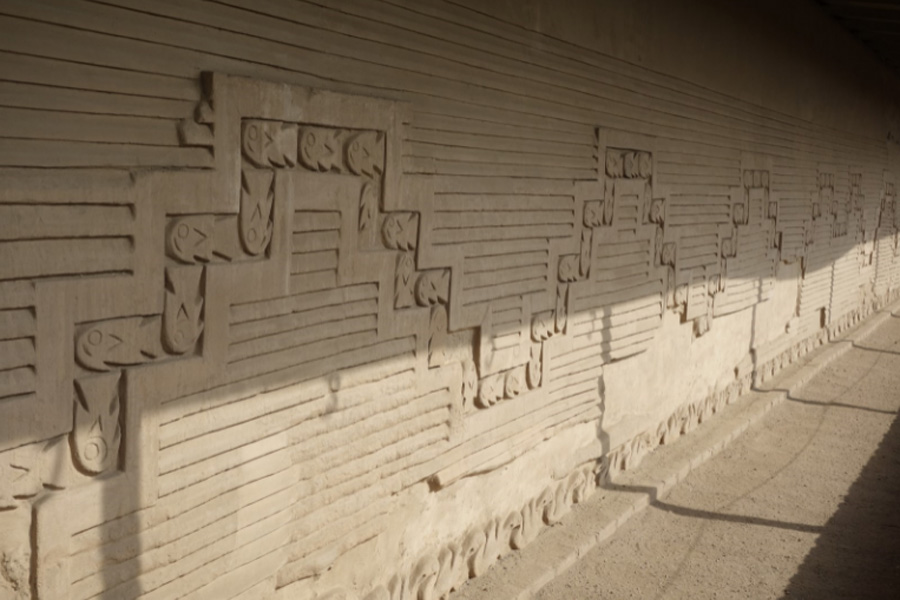In the coastal desert of the Moche valley in northern Peru, a huge, long abandoned city of mud and stone lies amidst the sands. Chan Chan was the capital of the Chimor Kingdom which was the pre-eminent power in the region during the years 1100 to 1470 AD. It was one of the largest cities in pre-Columbian America.
It reigned as the capital of the historical empire until, as with so many independent cultures, the Chimu (as the people of Chimor were called) were defeated and incorporated into the Inca Empire. The scale and organization of the site reflect a strict social and political strategy indicating a civilized and industrious population.
Etymology
The name is likely derived from the Quingnam “Jiang” or “Chang”. Quingnam was the pre-Columbian language of the Chimu people. It loosely translates to Sun, which means that the city of Chan-Chan would translate to “Sun-Sun”.
Translators have theorized that the true meaning would be something along the lines of “Great Sun”, “Resplendent Sun”, or “Splendid Sun” or. A typical feature of the Quingnam language was the replication of the same word would give it a different meaning, perhaps providing emphasis on the following word as we see here.
History of the City
Chan Chan is believed to have been constructed from 850 AD, centuries before the Chimu rose to power. It grew to be vast, with a population potentially as high as 40,000-60,000 people.
The city itself was built in a prosperous location in which they could utilize agricultural skills by building an extensive irrigation system using canals. Later, the city found itself even more wealthy as the people led successful military campaigns and extracted tribute from the locals.

At its zenith, Chan Chan covered 20 square kilometers (7.7 square miles), making it the largest city ever discovered in the Andes region. It was a hub of a vast trade and tribute, and the ruins suggest that more than 25,000 craftsmen lived there.
These people often came from the surrounding area, forcibly removed from their home after they had been conquered. They produced high-quality goods for both domestic consumption and exportation.
Raw materials that have been found in the area included gold, tropical feathers, and foodstuffs, but the most interesting discoveries may be the spondylus shells. These unusual molluscs were common off the coast of Chan Chan, but lived in waters too deep to be retrieved by the fisherman, which made them highly valued for jewelry.
The Chimu People
The traditional founding ruler of the Chimu was Taycanamo. He is supposed to have been born from a golden egg and then arrived from the sea. Later rulers expanded the kingdom into the Moche valley, and from there to the Santa and Zana Valleys.
- The Sky Fortress Of Kuelap And Cliffside Mummies Of The Chachapoyas
- Crystal Skulls Mystery – Misunderstanding or Hoax?
Guacricaur and Nancenpinco, descendants of Taycanamo were considered the architects of this expansions. They continued to spread further to the south and by 1375 conquered the neighboring Lambayeque peoples.
The La Leche valley was the next target and was brought under Chimu control through the 14th and 15th centuries. The Chimu were now at their height. The reign of Minchancaman, around the year 1400, saw the Chimu influence stretch some 1,300 km (800 miles) along the coast of northern Peru.

With the growth of their empire, the Chimu required administrative centers to be set up in the neighboring valleys and along the coast, which included places such as Farfan, Manchan, El Milagro, and the great monolithic fortress-city of Paramonga. Chan Chan, however, remained the supreme center of the Chimu world.
Well-Preserved and Wondrous
Chan Chan has been preserved remarkably well by the dry desert environment, but the first sense a modern visitor has of the place is one of emptiness. Huge courtyards open, one from another, exposed to the sun and surrounded by high walls, but with no evidence remaining of the living city within.
The city does not have a recognizable center and spreads out in a series of blocks, split with stone-lined canals or punctuated with small man-made lakes and wells. The architecture is characterized by buildings using prepared sections of poured mud.
The palace compounds are the most impressive part of the city. Huge even by Chimor standards, they likely served multiple functions as a royal residence, storage warehouse, mausoleum, and administrative center.
Over the years, a staggering ten royal palaces were constructed at Chan Chan. This potentially indicates that the royal inheritance protocol of the Chimu society allowed for the inheritance of title but perhaps not of wealth.
It appears that the new king would be required to build a new palace, whilst the family of the late king would continue to live in the current palace. This seems to indicate a sophisticated society and had the added benefit of ensuring the ruler continued to expand the empire.
The walls of the compounds, far higher than a man, were built to restrict access to the commoners and were decorated on the outside with bold designs. These were usually geometric shapes, animals, or sea life.

The inside compound walls had niches for wooden decorative masks and figurines. Precious art objects would likely have also been stored here.
- Cahokia Mounds: The Largest Ancient City in North America
- Africa’s Strange Ruin: What Exactly Is Great Zimbabwe?
The distinctive patterns cut into the walls may have even reflected textile wall hangings or basketworks that decorated the compound. Similar compounds across the Chimor empire show parallel designs.
Exterior compounds at Chan Chan are more modest. These were probably the residences of the administrators as they show a symmetry with the larger palace complex. Finally, on the outside of the city, two burial-like pyramid mounds have been found, indicating burial rites.
Fall of the Chimu
Chan Chan sadly lost its place of prominence around the year 1470 when the unstoppable Inca came to the city. They conquered the people and broke up the Chimu empire, taking many of the Chan Chan craftsmen to their own capital, Cuzco, 950 km (600 miles) to the southeast.
By the time the Spanish conquistadors arrived in 1532 under Francisco Pizarro, the city had largely been abandoned. The monolithic internal and external walls still stood, but the people were gone.
Contemporary reports from the Spanish expedition described the walls and architecture as being adorned with precious metals. One story indicates that a doorway was completely covered in silver, that today would be worth around $2 million.
As a result, Chan Chan faced severe pillaging from the Spaniards who formed mining companies to extract all of the gold and silver from the city. While much of the city infrastructure was undamaged, the treasures of the Chimu were forever lost.
Chan Chan Today
The ancient structures of Chan Chan are currently threatened by erosion through heavy rains, flooding, and strong winds. Chan Chan is the largest mud city in the world and as such its fragile building material causes concern, especially during the storms of El Nino years.
The increased rains have also led to increased humidity. This has allowed for salt contamination and vegetation growth in the bases of the compound. This has caused further damage to the integrity of Chan Chan’s foundations.
Chan Chan plays an essential role in understanding the culture and history of the South American peoples before the arrival of the Incas and Spanish Conquistadors. As a monolithic mud city standing proud of the desert, it perhaps has no equal.
Top Image: A Chimu sculpture against the decorated monolithic walls of Chan Chan. Source: JeremyRichards / Adobe Stock.
By Kurt Readman